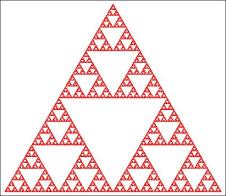Pascal’s triangle is one of the most famous of all mathematical diagrams, simple to construct and yet rich in mathematical patterns. These can be found by a web search, but their discovery by study of the diagram is vastly more satisfying, and there is always a chance of finding something never seen before [TM212 or search for “thatsmaths” at irishtimes.com].

A Long History
French mathematician, philosopher and theologian Blaise Pascal was first to make a comprehensive study of the triangle. However, it was known much earlier. Its invention cannot be credited to any single individual. Early Indian and Chinese mathematicians used the triangle for the summations of mathematical series. In India, the pattern was first employed by Pingala (c. 200 BC). In China, it is found in the treatise The Precious Mirror of the Four Elements (1303) by Zhu Shijie. Some 350 years before Pascal, he used the arithmetic triangle for the extraction of roots.
Later, in the Islamic world, the Persian poet, astronomer and mathematician Omar Khayyam (1048–1131) devised a method of finding roots based on the binomial expansion, in which context the triangle naturally arises. In Iran, it is still called the Khayyam triangle today.
A binomial is an expression involving the sum of two quantities ( a + b ). When multiplied by itself n times and expanded, the individual terms of the product are powers of a and b multiplied by coefficients. The triangle is a geometric arrangement of these binomial coefficients, which play an essential role in the theory of combinations and permutations. Pascal discovered the important connection between these coefficients and the theory of probability.
Patterns
The British mathematician G H Hardy described a mathematician as “a maker of patterns, like a painter or poet”. Indeed, the search for patterns that may simplify or unify results is a central preoccupation of mathematical research. We can illustrate this tendency by searching in the arithmetic triangle.
Here is a recipe to construct the triangle: take a large sheet of paper and write the first ten or twenty rows. At the centre top, write 1. Just below it, write two more 1’s forming a small triangle. On each following row, write a 1 at each end and at each position between them, write the sum of the numbers above it. The figure above shows the first few rows of the arithmetic triangle. A few minutes study will reveal several well-known sequences of numbers.
First, let us sum the numbers in each row. We find the sequence 1, 2, 4, 8, 16, … , the sequence of powers of 2. Now look at the diagonals slanting from top right to bottom left. The first is just a sequence of 1’s. The next is the sequence of natural numbers: 1, 2, 3, 4 … . The third gives the triangular numbers: 1, 3, 6, 10, … with each being a sum of natural numbers: 1, 1+2, 1+2+3, … . The fourth diagonal gives the tetrahedral numbers: 1, 4, 10, 20, …, the numbers of dots needed to make pyramids with triangular bases.
This pattern may be continued, but let us look at the triangle another way: summing the terms on diagonals sloping more gently, we soon discover the sequence 1, 1, 2, 3, 5, 8, … which some readers may recognise as the sequence of Fibonacci numbers, each entry being the sum of the preceding two numbers. This remarkable sequence turns up in the most unexpected places, and is closely related to the golden number, which has inspired artists through the ages.

Numbering the rows of the triangle, starting from from 0, and counting the terms in the nth row from 0 to n, the number at position (n, k) is “n-choose-k”, the number of ways of choosing k items from a set of n. Thus, the number at position 5 in row 52 is “52-choose-5”, the number of possible poker hands. Its value is over two and a half million.
More shocking is the number of arrangements of a deck of cards. It is factorial-52, which is about 8 followed by 67 zeros. Thus, a randomly chosen ordering of the cards has never before occurred in the history of the universe.
Another surprise is the fractal pattern that emerges if all the even numbers in the triangle are replaced by blanks. At each scale, the result is an approximation to the Sierpinski triangle, a set of dimension log 3 / log 2. Further study of Pascal’s triangle will continue to reveal new results.
